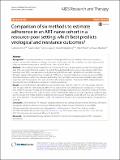| dc.contributor.author | Orrell, Catherine | en_US |
| dc.contributor.author | Cohen, Karen | en_US |
| dc.contributor.author | Leisegang, Rory | en_US |
| dc.contributor.author | Bangsberg, David R. | en_US |
| dc.contributor.author | Wood, Robin | en_US |
| dc.contributor.author | Maartens, Gary | en_US |
| dc.date.accessioned | 2017-05-01T19:27:13Z | |
| dc.date.issued | 2017 | en_US |
| dc.identifier.citation | Orrell, Catherine, Karen Cohen, Rory Leisegang, David R. Bangsberg, Robin Wood, and Gary Maartens. 2017. “Comparison of six methods to estimate adherence in an ART-naïve cohort in a resource-poor setting: which best predicts virological and resistance outcomes?” AIDS Research and Therapy 14 (1): 20. doi:10.1186/s12981-017-0138-y. http://dx.doi.org/10.1186/s12981-017-0138-y. | en |
| dc.identifier.issn | | en |
| dc.identifier.uri | http://nrs.harvard.edu/urn-3:HUL.InstRepos:32630529 | |
| dc.description.abstract | Background: Incomplete adherence to antiretroviral therapy (ART) results in virologic failure and resistance. It remains unclear which adherence measure best predicts these outcomes. We compared six patient-reported and objective adherence measures in one ART-naïve cohort in South Africa. Methods: We recruited 230 participants from a community ART clinic and prospectively collected demographic data, CD4 count and HIV-RNA at weeks 0, 16 and 48. We quantified adherence using 3-day self-report (SR), clinic-based pill count (CPC), average adherence by pharmacy refill (PR-average), calculation of medication-free days (PR-gaps), efavirenz therapeutic drug monitoring (TDM) and an electronic adherence monitoring device (EAMD). Associations between adherence measures and virologic and genotypic outcomes were modelled using logistic regression, with the area under the curve (AUC) from the receiver operator characteristic (ROC) analyses derived to assess performance of adherence measures in predicting outcomes. Results: At week 48 median (IQR) adherence was: SR 100% (100–100), CPC 100% (95–107), PR-average 103% (95–105), PR-gaps 100% (95–100) and EAMD 86% (59–94), and efavirenz concentrations were therapeutic (>1 mg/L) in 92%. EAMD, PR-average, PR-gaps and CPC best predicted virological outcome at week 48 with AUC ROC of 0.73 (95% CI 0.61–0.83), 0.73 (95% CI 0.61–0.85), 0.72 (95% CI 0.59–0.84) and 0.64 (95% CI 0.52–0.76) respectively. EAMD, PR-gaps and PR-average were highly predictive of detection of resistance mutations at week 48, with AUC ROC of 0.92 (95% CI 0.87–0.97), 0.86 (0.67–1.0) and 0.83 (95% CI 0.65–1.0) respectively. SR and TDM were poorly predictive of outcomes at week 48. Conclusion: EAMD and both PR measures predicted resistance and virological failure similarly. Pharmacy refill data is a pragmatic adherence measure in resource-limited settings where electronic monitoring is unavailable. Trial registration The trial was retrospectively registered in the Pan African Clinical Trials Registry, number PACTR201311000641402, on the 13 Sep 2013 (www.pactr.org). The first participant was enrolled on the 12th July 2012. The last patient last visit (week 48) was 15 April 2014 Electronic supplementary material The online version of this article (doi:10.1186/s12981-017-0138-y) contains supplementary material, which is available to authorized users. | en |
| dc.language.iso | en_US | en |
| dc.publisher | BioMed Central | en |
| dc.relation.isversionof | doi:10.1186/s12981-017-0138-y | en |
| dc.relation.hasversion | http://www.ncbi.nlm.nih.gov/pmc/articles/PMC5379739/pdf/ | en |
| dash.license | LAA | en_US |
| dc.subject | HIV | en |
| dc.subject | Antiretroviral therapy | en |
| dc.subject | Adherence | en |
| dc.subject | Electronic monitoring | en |
| dc.subject | Virological outcome | en |
| dc.subject | HIV-1 resistance | en |
| dc.subject | Genotyping | en |
| dc.title | Comparison of six methods to estimate adherence in an ART-naïve cohort in a resource-poor setting: which best predicts virological and resistance outcomes? | en |
| dc.type | Journal Article | en_US |
| dc.description.version | Version of Record | en |
| dc.relation.journal | AIDS Research and Therapy | en |
| dc.date.available | 2017-05-01T19:27:13Z | |
| dc.identifier.doi | 10.1186/s12981-017-0138-y | * |


